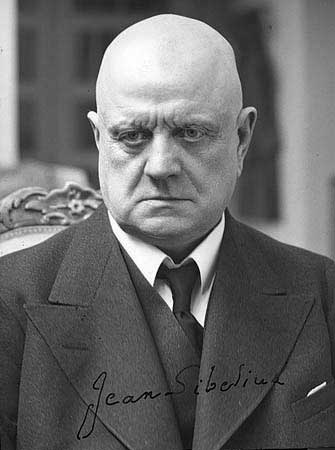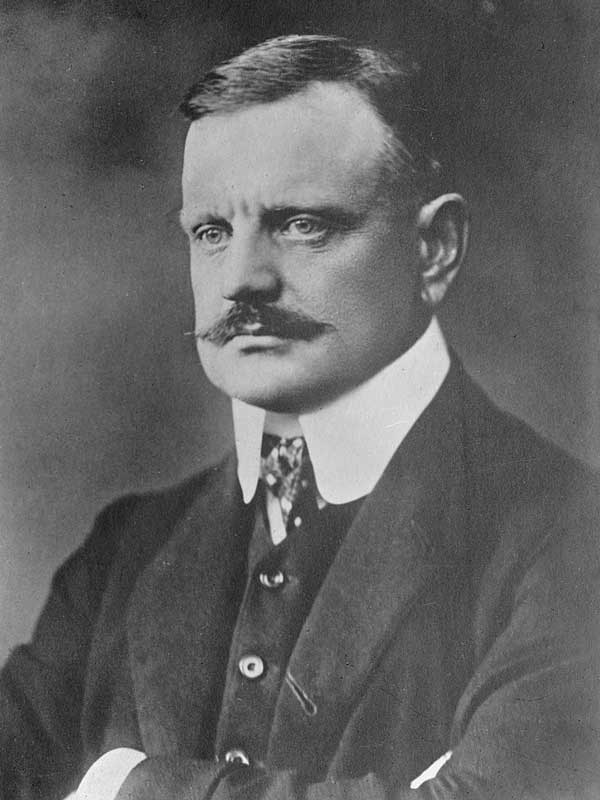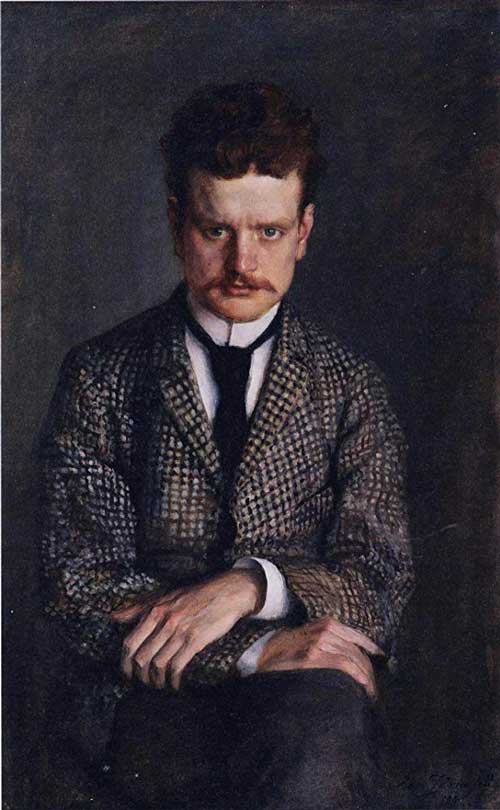Overview
Works Directory
Top Works
Photos
Biography
Jean Sibelius , born Johan Julius Christian Sibelius (8 December 1865 – 20 September 1957), was a Finnish violinist and composer of the late Romantic and early-modern periods. Widely recognized as his country's national composer, Sibelius is often credited for supporting the rise of the Finnish national identity in the country's struggle for independence.
The core of his oeuvre is his set of seven symphonies which, like his other major works, continue to be performed and recorded in his home country and internationally. In addition to his symphonies, Sibelius's best-known compositions include Finlandia, the Karelia Suite, Valse triste, the Violin Concerto, the choral symphony Kullervo, and The Swan of Tuonela (from the Lemminkäinen Suite). Other works include pieces inspired by the Finnish national epic, the Kalevala, over a hundred songs for voice and piano, incidental music for numerous plays, the opera Jungfrun i tornet (The Maiden in the Tower), chamber music, piano music, Masonic ritual music, and 21 publications of choral music. Throughout his career, the composer found inspiration in nature and Nordic mythology, especially the heroic legends of the national epic, the Kalevala.
Sibelius composed prolifically until the mid-1920s but after completing his Seventh Symphony (1924), the incidental music to The Tempest (1926), and the tone poem Tapiola (1926), he failed to produce any major works in his last thirty years, a stunning and perplexing decline commonly referred to as 'The Silence of Järvenpää', the location of his home. Although he is reputed to have stopped composing, he attempted to continue writing, including abortive efforts on an eighth symphony. In later life, he wrote Masonic music and re-edited some earlier works while retaining an active but not always favourable interest in new developments in music.
The Finnish 100 mark note featured his image until 2002 when the euro was adopted. Since 2011, Finland has celebrated a Flag Day on 8 December, the composer's birthday, also known as the "Day of Finnish Music". In 2015, the 150th anniversary of the composer's birth, a number of special concerts and events have been planned, especially in the city of Helsinki.
Musical style
Like many of his contemporaries, Sibelius was initially enamored by the music of Wagner. A performance of Parsifal at the Bayreuth Festival had a strong effect on him, inspiring him to write to his wife shortly thereafter, "Nothing in the world has made such an impression on me, it moves the very strings of my heart." He studied the scores of Wagner's operas Tannhäuser, Lohengrin, and Die Walküre intently. With this music in mind, he began work on an opera of his own, entitled Veneen luominen (The Building of the Boat). However, his appreciation for Wagner waned and he ultimately rejected Wagner's Leitmotif compositional technique, considering it to be too deliberate and calculated. Departing from opera, he later used the musical material from the incomplete Veneen luominen in his Lemminkäinen Suite (1893). He did, however, compose a considerable number of songs for voice and piano, whose early interpreters included Aino Ackté and above all Ida Ekman.
More lasting influences included Ferruccio Busoni, Anton Bruckner and Tchaikovsky. Hints of Tchaikovsky's music are particularly evident in works such as Sibelius' First Symphony (1899) and his Violin Concerto (1905). Similarities to Bruckner are most strongly felt in the 'unmixed' timbral palette and sombre brass chorales of Sibelius' orchestration, a fondness for pedal points, and in the underlying slow pace of the music.
Sibelius progressively stripped away formal markers of sonata form in his work and, instead of contrasting multiple themes, focused on the idea of continuously evolving cells and fragments culminating in a grand statement. His later works are remarkable for their sense of unbroken development, progressing by means of thematic permutations and derivations. The completeness and organic feel of this synthesis has prompted some to suggest that Sibelius began his works with a finished statement and worked backwards, although analyses showing these predominantly three- and four-note cells and melodic fragments as they are developed and expanded into the larger "themes" effectively prove the opposite.
This self-contained structure stood in stark contrast to the symphonic style of Gustav Mahler, Sibelius' primary rival in symphonic composition. While thematic variation played a major role in the works of both composers, Mahler's style made use of disjunct, abruptly changing and contrasting themes, while Sibelius sought to slowly transform thematic elements. In November 1907 Mahler undertook a conducting tour of Finland, and the two composers were able to take a lengthy bath together, leading Sibelius to comment:
I said that I admired [the symphony's] severity of style and the profound logic that created an inner connection between all the motifs ... Mahler's opinion was just the reverse. 'No, a symphony must be like the world. It must embrace everything.'
However, the two rivals did find common ground in their music. Like Mahler, Sibelius made frequent use of both folk music and literature in his compositions. The Second Symphony's slow movement was sketched from the motif of Il Commendatore in Don Giovanni, while the stark Fourth Symphony combined work for a planned "Mountain" symphony with a tone poem based on Edgar Allan Poe's The Raven. Sibelius also wrote several tone poems based on Finnish poetry, beginning with the early En Saga and culminating in the Tapiola (1926), his last major composition.
Over time, he sought to use new chord patterns, including naked tritones (for example in the Fourth Symphony), and bare melodic structures to build long movements of music, in a manner similar to Joseph Haydn's use of built-in dissonances. Sibelius would often alternate melodic sections with noble brass chords that would swell and fade away, or he would underpin his music with repeating figures which push against the melody and counter-melody.
Sibelius' melodies often feature powerful modal implications: for example much of the Sixth Symphony is in the (modern) Dorian mode. He studied Renaissance polyphony – as did his contemporary, the Danish composer Carl Nielsen – and his music often reflects this early trend. He often varied the movements in a piece by changing the note values of melodies, rather than the conventional change of tempi. He would often draw out one melody over a number of notes, while playing a different melody in shorter rhythm. For example, his Seventh Symphony comprises four originally sketched movements fused into telescopical and partly parallel functions without pause, where every important theme is in C major or C minor; the variation comes from the time and rhythm. His harmonic language was often restrained, even iconoclastic, compared to that of many contemporaries who were already experimenting with musical Modernism. As reported by Neville Cardus in the Manchester Guardian in 1958:
Sibelius justified the austerity of his old age by saying that while other composers were engaged in manufacturing cocktails he offered the public pure cold water.
Reception
Sibelius exerted considerable influence on symphonic composers and musical life, at least in English-speaking and Nordic countries. The Finnish symphonist Leevi Madetoja was a pupil of Sibelius. In Britain, Vaughan Williams and Arnold Bax both dedicated their fifth symphonies to Sibelius. Furthermore, Tapiola is prominently echoed in both Bax's Sixth Symphony and Moeran's Symphony in G Minor. The influence of Sibelius' compositional procedures is also strongly felt in the First Symphony of William Walton. When these and several other major British symphonic essays were being written in and around the 1930s, Sibelius' music was very much in vogue, with conductors like Beecham and Barbirolli championing its cause both in the concert hall and on record. Walton's composer friend Constant Lambert even claimed that Sibelius was "the first great composer since Beethoven whose mind thinks naturally in terms of symphonic form". Earlier, Granville Bantock had championed Sibelius (the esteem was mutual: Sibelius dedicated his Third Symphony to the English composer, and in 1946 he became the first President of the Bantock Society). More recently, Sibelius was also one of the composers championed by Robert Simpson. Malcolm Arnold acknowledged his influence, and Arthur Butterworth also saw Sibelius' music as a source of inspiration in his work.
Eugene Ormandy and to a lesser extent, his predecessor Leopold Stokowski, were instrumental in bringing Sibelius' music to American audiences by frequently programming his works; the former developed a friendly relationship with Sibelius throughout his life. Later in life he was championed by critic Olin Downes, who wrote a biography of the composer.
In 1938 Theodor Adorno wrote a critical essay, notoriously charging that "If Sibelius is good, this invalidates the standards of musical quality that have persisted from Bach to Schoenberg: the richness of inter-connectedness, articulation, unity in diversity, the 'multi-faceted' in 'the one'." Adorno sent his essay to Virgil Thomson, then music critic of the New York Herald Tribune, who was also critical of Sibelius; Thomson, while agreeing with the essay's sentiment, declared to Adorno that "the tone of it [was] more apt to create antagonism toward [Adorno] than toward Sibelius". Later, the composer, theorist and conductor René Leibowitz went so far as to describe Sibelius as "the worst composer in the world" in the title of a 1955 pamphlet.
Perhaps one reason Sibelius has attracted both the praise and the ire of critics is that in each of his seven symphonies he approached the basic problems of form, tonality, and architecture in unique, individual ways. On the one hand, his symphonic (and tonal) creativity was novel, while others thought that music should be taking a different route. Sibelius' response to criticism was dismissive: "Pay no attention to what critics say. No statue has ever been put up to a critic."
In the latter decades of the twentieth century, Sibelius began to be re-assessed more favourably: Milan Kundera dubbed the composer's approach to be that of "antimodern modernism", standing outside the perpetual progression of the status quo. In 1990, the composer Thea Musgrave was commissioned by the Helsinki Philharmonic Orchestra to write a piece in honour of the 125th anniversary of Sibelius' birth: Song of the Enchanter was premiered on 14 February 1991. In 1984, American avant-garde composer Morton Feldman gave a lecture in Darmstadt, Germany, wherein he stated that "the people you think are radicals might really be conservatives – the people you think are conservatives might really be radical," whereupon he began to hum Sibelius' Fifth Symphony.
Sibelius has fallen in and out of fashion but remains one of the most popular twentieth century symphonists, both in the concert hall and on record. Sibelius had spent much time producing profitable chamber music for home use, salon music, occasional works for the stage and other incidental music, all of which has now been systematically recorded on BIS Records' complete Sibelius Edition. This major editorial project to record every note of Sibelius also encompasses surviving sketches and early versions of his major works.
With 8 December 2015 being the 150th anniversary of Sibelius' birth, the Helsinki Music Centre has planned an illustrated and narrated "Sibelius Finland Experience Show" every day during

Index: 9.2
Type: Person Male
Period: 1865.12.8 - 1957.9.20
Age: aged 91
Area :Finland
Occupation :Composer
Periods :Romantic Music / Modernist Music








